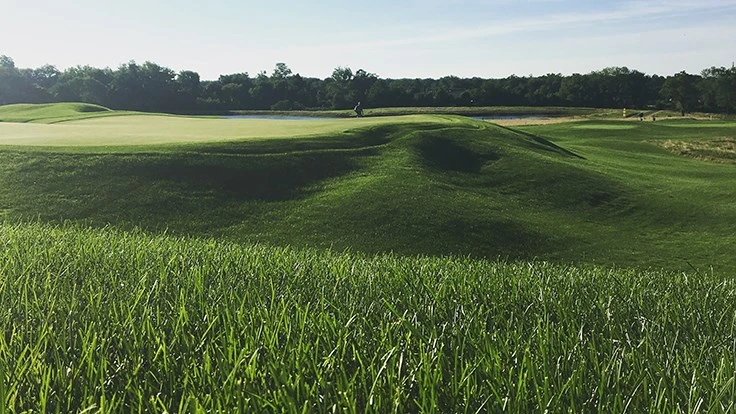
 A public golf course with the motto "A Country Club for a Day," Bulle Rock Golf Course in Havre de Grace, Md., is ranked as Number One Daily Fees Course in the state. It's a ranking Golf Course Superintendent Bill Lewis worked hard to achieve and plans to keep.
A public golf course with the motto "A Country Club for a Day," Bulle Rock Golf Course in Havre de Grace, Md., is ranked as Number One Daily Fees Course in the state. It's a ranking Golf Course Superintendent Bill Lewis worked hard to achieve and plans to keep.
"We rely on repeat business, so we treat every golfer like a member," says Lewis, who came to the course in fall 1998, soon after it opened. "Our goal is to get all work done ahead of play and produce championship conditions on a daily basis."
Designed by Pete Dye, Bulle Rock was named for the first thoroughbred racehorse brought to America. Located just north of Baltimore in rolling Maryland horse country, the course features bentgrass greens, tees and fairways, with turf-type tall fescue and bluegrass roughs. Its total 250 acres includes 120 acres of maintained turf and 130 acres of wooded and naturalized areas.
High heat and humidity, along with heavy red clay soils, lead to challenges with dollar spot on bentgrass fairways during summer months. "I would spray a lot less if it weren't for those conditions," notes Lewis, who holds a degree in turfgrass management from Ohio State University. "All things considered, fairways drain pretty well because of comprehensive subsurface drainage installed during grow-in."
Proper fertility is at the top of the list for Lewis's maintenance practices. "With the high humidity we get in this area, too much nitrogen definitely leads to flush growth," he adds. "I'm very cognizant of giving turf plants exactly what they need for steady growth. We soil-test fine-turf areas several times a year and order special fertility blends based on results."
Working with Harrell's Turf, Lewis uses POLYON Controlled-Release Fertilizer from Koch Turf & Ornamental. He typically applies the product to greens, tees, fairways roughs once in the spring and then spoon-feeds greens throughout summer months. His average formulation for greens is "along the lines" of 12-0-22.
"I want a 1:3 ratio of nitrogen to potassium on my greens, because potassium is good for salt levels," he explains. "It encourages a more vertical, upright growth pattern and helps during heat stress. It also helps with our water source."
 High Salts in Water Source
High Salts in Water SourceBulle Rock's water source is a two-mile pipeline to the Susquehanna River. Salt levels in the Chesapeake Bay move to the top of the river, where the golf course pipeline starts. Because of high salt levels, especially during summer months, potassium is key to keeping turf plants hardy.
"Water quality is hugely important on a golf course," says Lewis. "If you don't have good water, your turf won't be healthy. We installed an acid injection system that helps buffer pH down to 6.6 or so. The system takes bicarbonates out of the water and reduces salt levels. It makes our water more like rain water."
After installing the acid injection system, Lewis reduced water usage on the golf course by 25 percent. He credits good water quality and POLYON with keeping his turf as healthy as possible. Before switching to POLYON eight years ago, Lewis experienced flush growth, leading to excess clippings. His crews couldn't keep up with mowing.
"POLYON is not as influenced by heat as other products we've used. You want to give turf what it needs and when it needs it," Lewis adds. "You don't want to release nutrients all at once and then have nothing left, creating a feast or famine situation. POLYON works phenomenally to keep plants growing steadily throughout the year."
Other benefits of using POLYON include:
• Temperature-driven nutrient release which is not affected by excess rainfall.
• Consistent, predictable feeding with minimal surge growth.
• Fewer applications, which saves time, material and labor, as well as wear and tear on equipment.
• Low potential for nutrient leaching, run-off or volatization.
"It s a negative image for a golf course to have surplus clippings and inconsistent play," Lewis says. "We want our customers to return for the same great conditions every visit."
Bulle Rock averages 20,000 rounds per year. Lewis keeps the course open all winter long, closing only for a few days each fall during aerification. The course hosted the McDonald's LPGA Championship for five years from 2004 - 2009.
"It was a thrill of a lifetime to see our golf course on national and international television," adds Lewis. "But an even bigger thrill was seeing the pride my crew members took in providing the excellent conditions we worked so hard to achieve."
Latest from Golf Course Industry
- The Fittest Podcast in Turf: Episode 1
- GCSAA announces Grassroots Ambassador Leadership Award recipients
- Reel Turf Techs: David Gummo
- PBI-Gordon promotes two to executive level
- VIDEO: A First Green morning
- Bloom Golf Partners adds HR expert
- Seeking sustainability in Vietnam
- Kerns featured in Envu root diseases webinar






